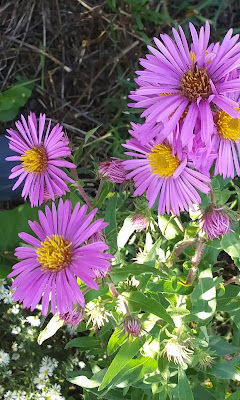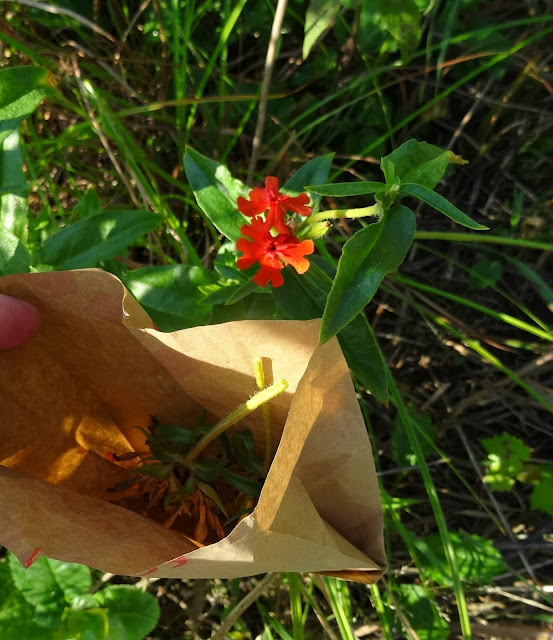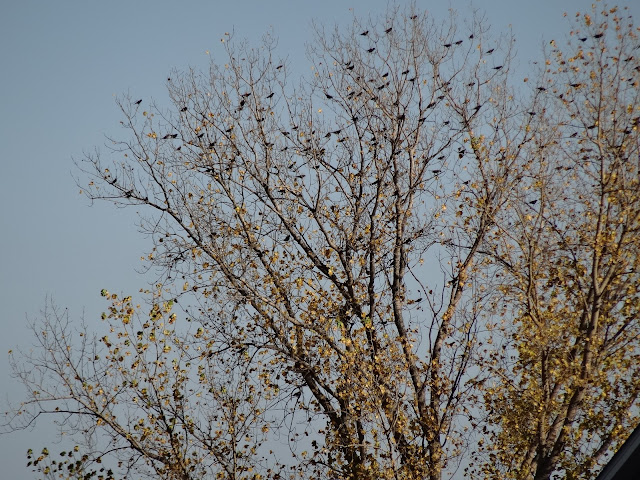11/07/2023
new feathers
In November, Mallards paddle on the pond before they migrate to warmer places. The male Mallards molt their feathers in the autumn and regrow their green head feathers; in the following spring brilliant colors will help each male find a mate for the next breeding season.
11/04/2022
10/28/2022
heat wave in October
70+ degrees F. !! Wonderful autumn weather.
Turtle still sunning on rocks in the pond.
Frog jumping when I venture into the wetland.
Mallard pair still paddling around, feeding.
New England Aster Symphyotrichum novae-angliae blooming.
10/12/2022
first snow 2022
Snow overnight. The log is totally exposed, because we are down more than 8 inches of precipitation.
10/03/2022
canada milkvetch
Seed pods of Canada Milkvetch are beginning to dry enough to spill the tiny seeds. In the background is the ubiquitous white asters that grow everywhere among native wildflowers at this time of the year.
10/01/2022
11/08/2021
leaf galls
This fallen leaf has galls all over it, lumps or complicated structures that look like capsules containing something mysterious. Galls are made by one of 1500 species of gall producers -- mostly insects and mites. Some galls form on leaves where insects feed on the plant matter, or lay eggs. Galls may also develop as a response to infections by fungi, bacteria, or viruses. Dissecting the gall is the only sure way to tell what caused it. That's a whole different adventure!
10/20/2021
mallards showing off
10/18/2021
black birds roosting
10/01/2021
9/22/2021
golden alexanders, golden in autumn
Among the yellow, purple, and white flowers in the riparian area surrounding the pond, the Golden Alexanders Zizia aurea have long gone to seed.
They bloomed a sunny yellow in May and June. Now, the seeds still stand in umbels on strong stems. The entire plant material remaining turns a golden purple-tinged color -- lovely among the autumn asters.
9/20/2021
purple asters
9/18/2021
seed harvest
Birds are already pecking out the sunflower seeds (top) and goldenrod flowers are releasing each seed with pappus, a tuft of hair that helps it disperse in breezes (bottom).
11/09/2020
temperamental autumn
11/02/2020
sparrow feeding on shore
Evidently there are still damselflies or dragonflies among the reeds and grasses on the shore. This sparrow scored one while hopping in the shallow water of the pond.
10/31/2020
surviving below freezing - turtles
Since we had several cold days and nights already, Painted Turtles Chrysemys picta who live in the pond are getting ready for winter. Lacking summer heat, this one was wandering very very slowly for a food item or a place to settle. Turtles will spend the next several months in frigid pond water below the frozen ice, with their metabolism and their heart rate slowed way down. They can absorb oxygen from the water through vascularized areas in their mouth, throat, and anus (cloacal respiration). But using oxygen produces lactic acid in their body, which the turtle counteracts with minerals released from its shell and bones. Painted Turtles do not eat during this time, but they do remain alert, especially to light from above. In Spring, when the hours of daylight increase, they will respond.
10/19/2020
seed heads
I have been wandering the riparian buffer and clipping some of the wildflower seed heads to distribute them around the pond. Some native wildflowers exist here already, and we want to spread desirable plants throughout the buffer.
The clipping process is "a few for spreading to make new plants, most left for the birds."
Even after the seeds are gone, the structure of the plant is interesting!
10/18/2020
boneset in autumn
Boneset Eupatorium perfoliatum has a stout hairy stem, and the plant's leaves occur along it opposite to one another. In autumn, the flowers go to seed, and leaves turn a rich red-brown color.
The leaves are described as 'perfoliate' because each joins the opposite leaf around the stem so it appears the stem grows through one large leaf. All parts of this plant are toxic and bitter. Birds rarely eat the seeds, but are attracted to the flowers for the many insects there.























